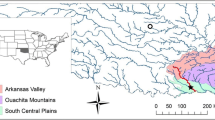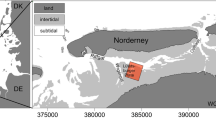Abstract
An oil seep site in the northern Gulf of Mexico is characterized by high backscattering levels on the GLORIA (Geological Long-Range Inclined Asdic) side-scan sonar images against a background of low backscattering. The high backscattering from the oil-seep area are most likely caused by a combination of small-scale roughness and porosity reduction due to the precipitation of CaCO3 formed during biodegradation of the oil-seep. Geostatistical methods have been applied to analyze side-scan images from both oil seep and nonseep areas. The results show that GLORIA images from oil seep areas can be distinguished from nonseep areas in terms of local histograms, variograms, and textural patterns. Pixels from seep and nonseep areas cluster into distinct groups on a textural feature plot. GLORIA side-scan images could be used as a reconnaissance tool to delineate oil and gas seep sites on the seafloor and thereby, reduce the dry-hole risk of petroleum exploration in deep-water frontier areas.
Similar content being viewed by others
References
Anderson, R. K., Scalan, R. S., Parker, P. L., Behrens, E. W., 1993, Seep oil and gas in Gulf of Mexico slope sediment: Science, v. 222, p. 619–622.
Behrens, E. W., 1988, Geology of a continental slope oil seep, norther Gulf of Mexico: American Association of Petroleum Geologists Bulletin, v. 72, no. 2, p. 105–114.
Behrens, E. W., Parker, P. L., and Scalan, R. S., 1984, Models and uses of porosity vs. CaCO3 and δ13C relationships in continental slope sediments northwest Gulf of Mexico (abstract): SEPM Midyear Meeting, San Jose, California, p. 11.
Chavez, P. S., Jr., 1986, Processing techniques for digital sonar images from GLORIA: Photogrammetric Engineering and Remote Sensing, v. 52, no. 8, p. 1133–1145.
EEZ-Scan 85 Scientific Staff, 1987, Atlas of the exclusive economic zone, Gulf of Mexico and Eastern Caribbean areas, United States Geological Survey Miscellaneous Investigation Series I-1864-A, 104p.
Gardner, J. V., Field, M. E., Lee, H., Edwards, B. E., Masson, D. G., Kenyon, N. H., and Kidd, R. B., 1991, Ground-truthing 6.5 kHz side-scan sonographs: what are we really imaging?: Journal of Geophysical Research, v. 96, no. B4, p. 5955–5974.
Gregory, A. R., 1977, Aspects of rock physics from laboratory and log data that are important to seismic interpretation,in Payton, C. E., ed., Seismic stratigraphy—applications to hydrocarbon exploration: American Association of Petroleum Geologists Bulletin, Memoir 26; p. 15–46.
Hovland, M. and Judd, A. G., 1988, Seabed pockmarks and seepages, impact on geology, biology and the marine environment: London, Grahan & Trotman, 293 p.
Huggett, Q. J. and Somers, M. L., 1988, Possibilities of using the GLORIA system for manganese nodule assessment: Marine Geophysical Researches, v. 9, no. 3, p. 255–264.
Johnson, H. P. and Helferty, M., 1990, The geological interpretation of side-scan sonar: Review of Geophysics, v. 28, no. 4, p. 357–380.
Kennicutt II, M. C. and Brooks, J. M., 1990, Recognition of areas effected by petroleum seepage: northern Gulf of Mexico continental slope: Geo-Marine Letters, v. 4, no. 10, p. 221–224.
Kenyon, N. H., 1992, Speculations on the geological causes of backscatter variation on GLORIA sonographs from the Mississippi and De Soto fans, Gulf of Mexico: Geo-Marine Letters, v. 12, p. 24–32.
Laughton, A. S., 1981, The first decade of GLORIA: Journal of Geophysical Research, v. 86, B12, p. 11511–11534.
Lee, H. J., Schwab, W. C., Kayen, R.E., Edwards, B. D., Twichell, D. C., Field, M. E., and Gardner, J. V., 1993, The relationship between side-scan sonar imagery and sediment physical properties: a comparison of two deep-sea fan system,in Proceedings of the Institute of Acoustics, v. 15, part 2, p. 319–326.
Macgregor, D. S., 1993, Relationships between seepage, tectonics, and subsurface petroleum reserves: Marine and Petroleum Geology, v. 10, no. 6, p. 606–619.
Martin, R. G. and Bouma, A. H., 1978, Physiography of Gulf of Mexico,in Bouma, A. H., Moore, G. T., and Coleman, J. M., eds., Framework, facies, and oil-trapping characteristics of the upper continental margin: American Association of Petroleum Geologists Studies in Geology, v. 7, p. 3–19.
Miller, R. L., Dwan, F. S., and Cheng, C. F., 1991, Digital preprocessing techniques for GLORIA II sonar images: Geo-Marine Letters, v. 11, p. 23–31.
Mitchell, N. C., 1991, Improving GLORIA images using sea beam data: Journal of Geophysical Research, v. 96, no. B1, p. 337–351.
Mo, Y., 1981. Numerical method for seismic data processing (in Chinese): Beijing, Petroleum Industry Publishing House, 278 p.
Scanlon, K. M. and Masson, D. G., 1992, Fe−Mn nodule field indicated by GLORIA, north of the Puerto Rico trench: Geo-Marine Letters, v. 12, p. 208–213.
Searle, R. C. and Hey, R. N., 1983, GLORIA observations of the propagating rift at 95.5°W on the Cocos-Nazca spreading center: Journal of Geophysical Research, v. 88, B8, p. 6433–6447.
Searle, R. C., Lebas, T. P., Mitchell, N. C., Somers, M. L., Parson, L. M., and Patriat, Ph., 1990, GLORIA image processing, the state of the art: Marine Geophysics Research, v. 9, p. 21–39.
Simm, R. W. and Kidd, R. B., 1984, Submarine debris flow deposits detected by long-range side-scan sonar 1,000-kilometers from source: Geo-Marine Letteers, v. 3, p. 13–16.
Sinding-Larsen, R. and Wen, R., 1990, Interpretation, characterization, and simulation of GLORIA sonography using a personal computer with a large database on CD-ROM: CODATA Bulletin, v. 22, no. 4, p. 79–96.
Somers, M. L., Carson, R. M., Revie, J. A., Edge, R. H., Barrow, B. J., and Andrews, A. G., 1978, GLORIA II—an improved long range side-scan sonar: Oceanology International' 78, Technical Session Journal, London, BPS Publications, p. 16–24.
Taner, M. T. and Sheriff, R. E., 1977, Application of amplitude, frequency, and other attributes to stratigraphic and hydrocarbon determination,in Payton, C. E., ed., Seismic stratigraphy—applications to hydrocarbon exploration: American Association of Petroleum Geologists Bulletin, Memoir 26, p. 301–327.
Wen, R., 1995, Exploring geomathematical frontiers in petroleum geology—fractal analysis, uncertainty assessments and geostatistical modeling of geo-images: Trondheim, Norway, Norwegian University of Science and Technology, Dr.ing thesis, 410 p., 221 figs.
Wen, R. and Sinding-Larsen, R., 1994, Image filtering by factorial kriging—sensitivity analysis, synthetic examples and applications to GLORIA side-scan sonar images from the Mississippi Fan,in Proceedings of the 1994 Annual meeting of international association of mathematical geology, October 3–5, Mont Tremblant, Québec, Canada, p. 346–360.
Wen, R., Sinding-Larsen, R., and Kenyon, N. H., 1995, Computer enhanced GLORIA side-scan sonar images of the surface of the Mississippi Fan,in Pickering, K. T., Hiscott, Hiscott, R. N. Kenyon, Ricci Lucchi, F., and Smith, R., eds., Atlas of deep water environments, architectural style in turbidites systems: London, Chapman & Hall, p. 297–299.
Author information
Authors and Affiliations
Rights and permissions
About this article
Cite this article
Wen, R., Sinding-Larsen, R. Mapping oil seeps on the sea floor by Gloria side-scan sonar images—A case study from the northern Gulf of Mexico. Nat Resour Res 5, 141–154 (1996). https://doi.org/10.1007/BF02257658
Received:
Accepted:
Issue Date:
DOI: https://doi.org/10.1007/BF02257658




